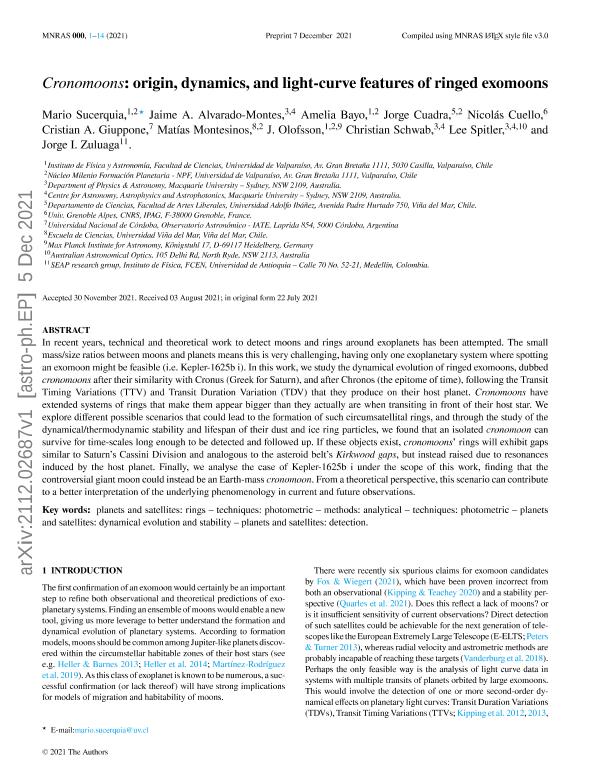Mostrar el registro sencillo del ítem
dc.contributor.author
Sucerquia, Mario
dc.contributor.author
Alvarado Montes, Jaime A.
dc.contributor.author
Bayo, Amelia
dc.contributor.author
Cuadra, Jorge
dc.contributor.author
Cuello, Juan Nicolás

dc.contributor.author
Giuppone, Cristian Andrés

dc.contributor.author
Montesinos, Matías
dc.contributor.author
Olofsson, J.
dc.contributor.author
Schwab, Christian
dc.contributor.author
Spitler, Lee
dc.contributor.author
Zuluaga, Jorge I
dc.date.available
2023-07-07T19:15:43Z
dc.date.issued
2022-05
dc.identifier.citation
Sucerquia, Mario; Alvarado Montes, Jaime A.; Bayo, Amelia; Cuadra, Jorge; Cuello, Juan Nicolás; et al.; Cronomoons: Origin, dynamics, and light-curve features of ringed exomoons; Oxford Univ Press Inc; Monthly Notices of the Royal Astronomical Society; 512; 1; 5-2022; 1032-1044
dc.identifier.issn
0035-8711
dc.identifier.uri
http://hdl.handle.net/11336/202789
dc.description.abstract
In recent years, technical and theoretical work to detect moons and rings around exoplanets has been attempted. The small mass/size ratios between moons and planets means this is very challenging, having only one exoplanetary system where spotting an exomoon might be feasible (i.e. Kepler-1625b i). In this work, we study the dynamical evolution of ringed exomoons, dubbed cronomoons after their similarity with Cronus (Greek for Saturn), and after Chronos (the epitome of time), following the Transit Timing Variations and Transit Duration Variation that they produce on their host planet. Cronomoons have extended systems of rings that make them appear bigger than they actually are when transiting in front of their host star. We explore different possible scenarios that could lead to the formation of such circumsatellital rings, and through the study of the dynamical/thermodynamic stability and lifespan of their dust and ice ring particles, we found that an isolated cronomoon can survive for time-scales long enough to be detected and followed up. If these objects exist, cronomoons' rings will exhibit gaps similar to Saturn's Cassini Division and analogous to the asteroid belt's Kirkwood gaps but instead raised due to resonances induced by the host planet. Finally, we analyse the case of Kepler-1625b i under the scope of this work, finding that the controversial giant moon could instead be an Earth-mass cronomoon. From a theoretical perspective, this scenario can contribute to a better interpretation of the underlying phenomenology in current and future observations.
dc.format
application/pdf
dc.language.iso
eng
dc.publisher
Oxford Univ Press Inc

dc.rights
info:eu-repo/semantics/openAccess
dc.rights.uri
https://creativecommons.org/licenses/by/2.5/ar/
dc.subject
METHODS: ANALYTICAL
dc.subject
PLANETS AND SATELLITES: DETECTION
dc.subject
PLANETS AND SATELLITES: DYNAMICAL EVOLUTION AND STABILITY
dc.subject
PLANETS AND SATELLITES: RINGS
dc.subject
TECHNIQUES: PHOTOMETRIC
dc.subject.classification
Astronomía

dc.subject.classification
Ciencias Físicas

dc.subject.classification
CIENCIAS NATURALES Y EXACTAS

dc.title
Cronomoons: Origin, dynamics, and light-curve features of ringed exomoons
dc.type
info:eu-repo/semantics/article
dc.type
info:ar-repo/semantics/artículo
dc.type
info:eu-repo/semantics/publishedVersion
dc.date.updated
2023-07-06T11:49:15Z
dc.journal.volume
512
dc.journal.number
1
dc.journal.pagination
1032-1044
dc.journal.pais
Reino Unido

dc.journal.ciudad
Oxford
dc.description.fil
Fil: Sucerquia, Mario. Universidad de Valparaíso; Chile
dc.description.fil
Fil: Alvarado Montes, Jaime A.. Macquarie University; Australia
dc.description.fil
Fil: Bayo, Amelia. Universidad de Valparaíso; Chile
dc.description.fil
Fil: Cuadra, Jorge. Universidad de Valparaíso; Chile. Universidad Adolfo Ibañez; Chile
dc.description.fil
Fil: Cuello, Juan Nicolás. Universite Grenoble Alpes.; Francia. Consejo Nacional de Investigaciones Científicas y Técnicas; Argentina
dc.description.fil
Fil: Giuppone, Cristian Andrés. Consejo Nacional de Investigaciones Científicas y Técnicas. Centro Científico Tecnológico Conicet - Córdoba. Instituto de Astronomía Teórica y Experimental. Universidad Nacional de Córdoba. Observatorio Astronómico de Córdoba. Instituto de Astronomía Teórica y Experimental; Argentina. Universidad Nacional de Córdoba. Observatorio Astronómico de Córdoba; Argentina
dc.description.fil
Fil: Montesinos, Matías. Universidad de Valparaíso; Chile. Universidad de Viña del Mar (uvm); Chile
dc.description.fil
Fil: Olofsson, J.. Universidad de Valparaíso; Chile
dc.description.fil
Fil: Schwab, Christian. Macquarie University; Australia
dc.description.fil
Fil: Spitler, Lee. Macquarie University; Australia
dc.description.fil
Fil: Zuluaga, Jorge I. Universidad de Antioquia; Colombia
dc.journal.title
Monthly Notices of the Royal Astronomical Society

dc.relation.alternativeid
info:eu-repo/semantics/altIdentifier/doi/http://dx.doi.org/10.1093/mnras/stab3531
dc.relation.alternativeid
info:eu-repo/semantics/altIdentifier/url/https://academic.oup.com/mnras/article-abstract/512/1/1032/6461099?redirectedFrom=fulltext
dc.relation.alternativeid
info:eu-repo/semantics/altIdentifier/arxiv/https://arxiv.org/abs/2112.02687
Archivos asociados
